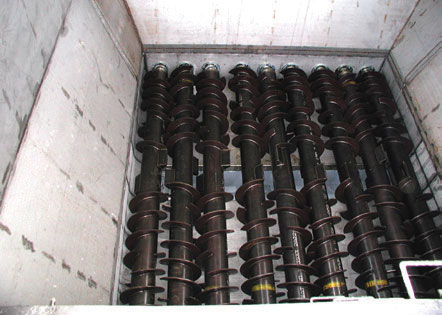A skip in time saves nine.
In recent years, legislation has allowed dewatered sludge to be returned to the land only if it had first been appropriately treated. One favoured method is stabilising the sludge by mixing it with quicklime (calcium oxide, CaO). This causes an exothermic reaction, helpfully raising the pH of the sludge and delivering the required high pathogen kill.
There are various types of equipment available for mixing sludge with quicklime. One of the most reliable and costeffective is to mix the sludge and quicklime in the hopper of a progressive cavity pump, which can then pump the product to closed containers. seepex pioneered this solution in the early 1980s and the company has continually adapted and improved its range of open hopper pumps to suit ever-increasing environmental demands. Having supplied dozens of plants throughout Europe and the UK, seepex pumps are now capable of handling non-flowable sludge from centrifuges, belt presses or hoppers where the dry solids content is as high as 45 %.
The starting situation
It was therefore perhaps unsurprising that in 2002 Dwr-Cymru Welsh Water approached seepex for a plant to treat and stabilise imported sludge cake at their Parc-Y-Splott sewage treatment works at Carmarthen. As well as being cost-effective, a requirement was that all the new plant had to be accommodated in the existing works.
The solution
 The solution that seepex determined was to build a 30 tonne reception silo (with a "live bottom") with a seepex silo pump underneath it. The sludge cake (of 20-30 % ds) is pumped 131 feet to a seepex lime mixer pump where the sludge is mixed with the quicklime. To minimise quicklime usage and so keep costs to a minimum, its addition is accurately controlled by a PLC controlled process. The stabilised cake is then pumped 100 feet to three closed containers.
The solution that seepex determined was to build a 30 tonne reception silo (with a "live bottom") with a seepex silo pump underneath it. The sludge cake (of 20-30 % ds) is pumped 131 feet to a seepex lime mixer pump where the sludge is mixed with the quicklime. To minimise quicklime usage and so keep costs to a minimum, its addition is accurately controlled by a PLC controlled process. The stabilised cake is then pumped 100 feet to three closed containers.
The benefit
 Despite the high percentage of dry solids, the system comfortably processes 88 tons of dewatered sludge cake daily.
Despite the high percentage of dry solids, the system comfortably processes 88 tons of dewatered sludge cake daily.
The benefits have not only come to the Parc-Y-Splott works. It is now much cheaper for Dwr-Cymru Welsh Water to dewater sludge cake on satellite sites and transport the cake (at 25-30 % ds) to than to transport the wet sludge (with only 3-4 % ds) as they had done previously. This has resulted in massive cost and environmental savings with only one sludge trip where previously there had been up to nine. Furthermore, Dwr-Cymru Welsh Water can now treat sludge cake from other sites if equipment there fails or is down for maintenance.
